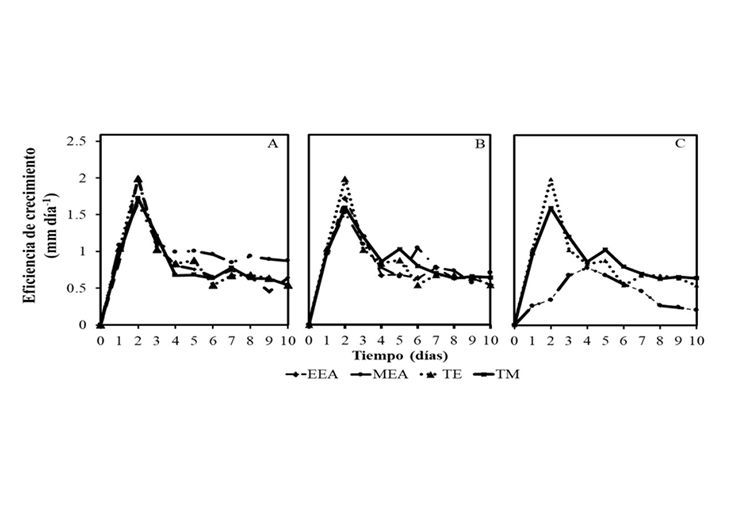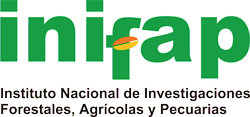Potential fungicidal effect of root extracts of Cucurbita foetidissima (Kunth) against Fusarium sp.
DOI:
https://doi.org/10.29312/remexca.v16i2.3523Keywords:
cucurbits, fusariosis, secondary metabolites, wild squashAbstract
The genus Fusarium affects a wide diversity of horticultural crops, generating significant economic losses. These fungi are capable of infecting plants during their development and even after harvest. The use of bioactive plant extracts is an environmentally friendly, non-harmful, and low-cost control strategy. Plant-based compounds have shown promise in the control of fungal diseases. Cucurbita foetidissima is a cucurbit with a high content of secondary metabolites present in its root with fungicidal power. The present work was conducted from 2017 to 2019 and it evaluated the antifungal effect of root extracts of C. foetidissima against different Fusarium species under in vitro conditions. Root ethanolic and methanolic extracts of C. foetidissima were obtained. The metabolites: phenols, flavonoids, terpenoids, and saponins were quantified. The antifungal capacity of the extracts on the growth of Fusarium oxysporum, F. equiseti, and F. solani was evaluated in vitro. Methanolic extracts had a higher concentration of phenols, terpenoids, and saponins compared to ethanolic extracts; the latter had a higher concentration of flavonoids. The ethanolic extract achieved a greater antifungal effect, inhibiting between 60 and 80% of the growth of the three Fusarium species. The root ethanolic extract of C. foetidissima has a moderate fungistatic capacity to inhibit the in vitro mycelial growth of different Fusarium species, suggesting the potential of its use to delay or attenuate the onset of symptoms associated with fusariosis.
Downloads
References
Al Aboody, M. S. A. and Mickymaray, S. 2020. Anti-fungal efficacy and mechanisms of flavonoids. Antibiotics. 26(2):1-42. Doi:10.3390/antibiotics9020045.
Ammar, M. I.; Gomah, E. N. and Abul, H. H. M. 2013. Antifungal activity of prenylated flavonoids isolated from Tephrosia apollinea L. against four phytopathogenic fungi. Crop Protection. 49(1):21-25. Doi.org/10.1016/j.cropro.2013.02.012.
Apodaca-Sánchez, M. Á.; Zavaleta-Mejía, E.; Osada-Kawasoe, S. y García-Espinoza, R. 2004. Hospedantes asintomáticos de Fusarium oxysporum Schlechtend. f. sp. radicis-lycopersici. Revista Mexicana de Fitopatología. 22(1):7-13.
Arif, T.; Bhosale, J. D.; Kumar, N.; Mandal, T. K.; Bendre, R. S.; Lavekar, G. S. and Dabur, R. 2009. Natural products antifungal agents derived from plants. Journal of Asian Natural Products Research. 11(7):621-638. Doi:10.1080/10286020902942350.
Chacón, C.; Miranda-Granados, J.; Ruiz-Lau, N.; Lagunas-Rivera, S.; Ruíz-Valdiviezo, V. M. and Gutiérrez-Miceli, F. A. 2021. In vitro antifungal activity and chemical composition of Piper auritum Kunth essential oil against Fusarium oxysporum and Fusarium equiseti. Agronomy. 11(6):1-13. Doi:10.3390/ agronomy11061098.
Chapagain, B. P.; Wiesman, Z. and Tsror, L. L. 2007. In vitro study of the antifungal activity of saponin-rich extracts against prevalent phytopathogenic fungi. Industrial Crops and Products. 26(2):109-115. Doi.org/10.1016/j.indcrop.2007.02.005.
DGSV-CNRF. 2020. Podredumbre de raíces por Fusarium spp. (Hypocreales: Nectriaceae) en maíz. SADER-SENASICA. Dirección General de Sanidad Vegetal-Centro Nacional de Referencia Fitosanitaria. Ficha técnica. 15 p. Tecámac, Estado de México. https://www.gob.mx/cms/uploads/attachment/file/600884/Podredumbre-de-ra-ces.pdf
Ekwomadu, T. I. and Mwanza, M. 2023. Fusarium fungi pathogens, identification, adverse effects, disease management, and global food security: a review of the latest research, Agriculture. 13(9):1-20. Doi.org/10.3390/agriculture13091810.
García-Granados, R. U.; Cruz-Sosa, F.; Alarcón-Aguilar, F. J.; Nieto-Trujillo, A. y Gallegos-Martínez, M. E. 2019. Análisis fitoquímico cualitativo de los extractos acuosos de Thalassia testudinum Banks ex Köning et Sims de la localidad de Champotón, Campeche, México, durante el ciclo anual 2016-2017. Polibotánica. 1(48):151-168. Doi:10.18387/polibotanica.48.12.
Ghorai, N. C. 2012. Terpenoids concentration in plant tissues using a monoterpene, Linalool as standard reagent. Protocol Exchange. 1(10):1-5. Doi:10.1038/protex.2012.055.
Gómez, G. A.; Rangel, G. J. M.; Morales, F. F.; Aquino, P. G.; Santana, G. M. A. y Silos, E. H. 2019. Diagnóstico de poblaciones silvestres de calabacilla loca en el Altiplano Central de México. Revista Mexicana de Ciencias Agrícolas. 10(7):1517-1528. doi.org/10.29312/remexca.v10i7.1693.
Gupta, S. M. and Kumar, K. 2017. In vitro antioxidant and anti-Rhizopus activity of methanolic seed extract of Camelina sativa L. Defense Life Science Journal. 2(1):59-64. Doi:10.14429/dlsj.2.10110.
Helaly, F. M.; Soliman, H. S.; Soheir, A. D. and Ahmed, A. A. 2001. Controlled release of migration of molluscicidal saponin from different types of polymers containing Calendula officinalis. Journal of the Polymer Processing Institute. 20(4):305-311. Doi.org/10.1002/adv.10005.
Isidro-Requejo, L. M.; Márquez-Ríos, E.; Toro-Sánchez, C. L.; Ruiz-Cruz, S.; Valero-Garrido, D. and Suárez-Jiménez, G. M. 2023. Tomato plant extract (Lycopersicon esculentum) obtained from agroindustrial byproducts and its antifungal activity against Fusarium spp. Frontiers in Sustainable Food Systems. 7(11):1-8. Doi:10.3389/fsufs.2023.1323489.
Kaushik, U.; Aeri, V. and Mir, S. R. 2015. Cucurbitacins an insight into medicinal leads from nature. Pharmacognosy reviews. 9(17):12-18. Doi:10.4103/0973-7847.156314.
Kiiker, R.; Juurik, M. and Heick, T. M. 2021. Changes in DMI, SDHI and QoI Fungicide sensitivity in the Estonian Zymoseptoria tritici population between 2019 and 2020. Microorganisms. 12-9(4):1-15. Doi:10.3390/microorganisms9040814.
Leslie, J. F. and Summerell, B. A. 2008. The Fusarium laboratory manual. Second Ed. Wiley Blackwell Publishing. Ames, IA, USA. 387 p.
Macías, S. K. L.; Juárez, F. B. I.; Cárdenas, O. N. C.; Aguirre, R. J. R. y Jasso, P. Y. 2009. Evaluación de plantas tradicionalmente utilizadas en la desinfección de heridas. Revista Mexicana de Ciencias Farmacéuticas. 40(2):5-10.
Mahgoub, S. A.; Qattan, S. Y. A.; Salem, S. S.; Abdelbasit, H. M.; Raafat, M.; Ashkan, M. F.; Al-Quwaie, D. A.; Motwali, E. A.; Alqahtani, F. S. and Abd El-Fattah, H. I. 2023. Characterization and biodegradation of phenol by Pseudomonas aeruginosa and Klebsiella variicola strains isolated from sewage sludge and their effect on soybean seeds germination. Molecules. 26-28(3):1-19. Doi:10.3390/molecules28031203.
Mehmood, A.; Javid, S.; Khan, M. F.; Ahmad, K. S. and Mustafa, A. 2022. In vitro total phenolics, total flavonoids, antioxidants and antibacterial activities of selected medicinal plants using different solvent systems. BMC Chemistry. 16(1):1-10. Doi:10.1186/s13065-022-00858-2.
Mejía-Morales, C.; Rodríguez-Macias, R.; Salcedo-Pérez, E.; Zamora-Natera, J. F.; Rodríguez-Zaragoza, F. A.; Molina-Torres, J.; Délano-Frier, J. P. and Zañudo-Hernández, J. 2021. Contrasting metabolic fingerprints and seed protein profiles of Cucurbita foetidissima and C. radicans fruits from federal plants sampled in Central Mexico. Plants. 10(11):1-22. Doi:10.3390/plants10112451.
Mohamed, A.; Yousef, S.; Nasser, W. S.; Osman, T. A.; Knebel, A.; Sánchez, E. P. V. and Hashem, T. 2020. Rapid photocatalytic degradation of phenol from water using composite nanofibers under UV. Environmental Science Europe. 32(12):1-8. Doi.org/10.1186/s12302-020-00436-0.
Mukherjee, P.K.; Singha, S.; Kar, A.; Chand, J.; Bonerjee, S.; Dasgupta, B.; Haldar, P. H. and Sharma, N. 2022. Therapeutic importance of Cucurbitaceae: a medicinally important family. Journal of Ethnopharmacology. 282(10):1-27. Doi.org/10.1016/j.jep.2021.114599.
Pérez-Delgado, O. y Vallejos-Campos, E. C. 2019. Actividad antifúngica in vitro del extracto crudo acuoso de Rosmarinus officinalis contra Candida albicans. Journal of the Selva Andina Research Society. 10(1):1-9. Doi:10.36610/j.jsars.2019.100100045.
Ramírez, P. G.; Ramírez, D. G.; Zavaleta-Mejía, E.; Ocampo, S. A.; Díaz, C. N. and Martínez, R. I. R. 2020. Extracts of Stevia rebaudiana against Fusarium oxysporum associated with tomato cultivation. Scientia Horticulturae. 259(9):1-6. Doi.org/10.1016/j.scienta.2019.108683.
Rangel-Guerrero, J. M.; Flores-Benitez, S.; Cadena-Iñiguez, J.; Morales-Flores, F. J. and Trejo-Téllez, B. I. 2018. Extracts of Cucurbita foetidissima (Kunth) fruits inhibit the growth of phytopathogens of agricultural interest. Agroproductividad. 11(10):107-115. Doi.org/10.32854/agrop.v11i10.1253.
Singleton, V. L.; Orthofer, R. y Lamuela-Raventós, R. M. 1999. Analysis of total phenols and other oxidation substrates and antioxidants by means of Folin-Ciocalteu reagent. Methods in Enzymology. 299(1):152-178. Doi.org/10.1016/S0076-6879(99)99017-1.
Tao, H.; Bao, Z.; Jin, C.; Miao, W.; Fu, Z. and Jin, Y. 2020. Toxic effects and mechanisms of three commonly used fungicides on the human colon adenocarcinoma cell line Caco-2. Environmental Pollution. 263(4):1-11. Doi.org/10.1016/j.envpol.2020.114660.
Tousson, T. A. and Nelson, P. E. 1976. Fusarium. A pictorial guide to the identification of Fusarium species according to the taxonomic system of Snyder and Hansen. 2a Ed. University Park y Londres. The Pennsylvania State University Press. 43 p.
Treviño, N. J. F.; Rodríguez, G. R. G.; Verde, S. M. J.; Morales, R. M. E.; Garza, P. R. A.; Rivas, M. C. y Oranday, C. A. 2012. Actividad antifúngica de Stenocereus pruinosus y Echinocereus stramineus. Revista Mexicana de Ciencias Farmacéuticas. 43(1):42-48.
Zhishen, J.; Mengcheng, T. and Jianming, W. 1999. The determination of flavonoid contents in mulberry and their scavenging effects on superoxide radicals. Food Chemistry. 64(4):555-559. Doi.org/10.1016/S0308-8146(98)00102-2.
Zhou, X.; Guo, H.; Zhang, L.; Yang, L.; Wei, Z.; Zhang, X. and Niu, Y. 2023. Crude saponins from Chenopodium quinoa Willd. Reduce Fusarium wilt infection in tomato seedlings. Horticulturae. 9(12):1-12. Doi.org/10.3390/horticulturae9121340.

Published
How to Cite
Issue
Section
License
Copyright (c) 2025 Revista Mexicana de Ciencias Agrícolas

This work is licensed under a Creative Commons Attribution-NonCommercial 4.0 International License.
The authors who publish in Revista Mexicana de Ciencias Agrícolas accept the following conditions:
In accordance with copyright laws, Revista Mexicana de Ciencias Agrícolas recognizes and respects the authors’ moral right and ownership of property rights which will be transferred to the journal for dissemination in open access. Invariably, all the authors have to sign a letter of transfer of property rights and of originality of the article to Instituto Nacional de Investigaciones Forestales, Agrícolas y Pecuarias (INIFAP) [National Institute of Forestry, Agricultural and Livestock Research]. The author(s) must pay a fee for the reception of articles before proceeding to editorial review.
All the texts published by Revista Mexicana de Ciencias Agrícolas —with no exception— are distributed under a Creative Commons License Attribution-NonCommercial 4.0 International (CC BY-NC 4.0), which allows third parties to use the publication as long as the work’s authorship and its first publication in this journal are mentioned.
The author(s) can enter into independent and additional contractual agreements for the nonexclusive distribution of the version of the article published in Revista Mexicana de Ciencias Agrícolas (for example include it into an institutional repository or publish it in a book) as long as it is clearly and explicitly indicated that the work was published for the first time in Revista Mexicana de Ciencias Agrícolas.
For all the above, the authors shall send the Letter-transfer of Property Rights for the first publication duly filled in and signed by the author(s). This form must be sent as a PDF file to: revista_atm@yahoo.com.mx; cienciasagricola@inifap.gob.mx; remexca2017@gmail.
This work is licensed under a Creative Commons Attribution-Noncommercial 4.0 International license.


